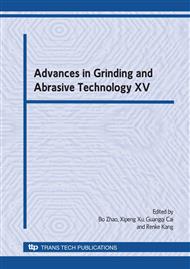p.563
p.568
p.572
p.578
p.583
p.588
p.593
p.598
p.603
Magnetorheological Flexible Gasbag Polishing Technique
Abstract:
Combining the advantages of rheological behavior of magnetorheological fluid (MRF) and flexibility adjustability of rubber gasbag, a magnetorheological flexible gasbag polishing technique applied to free-form mould is proposed. With the development of robotic gasbag polishing technique, the flexibility of rubber gasbag can be adjusted by three methods of changing its internal pressure controlled through a pressure control unit, its own material property and structural parameter, and the rheological behavior of MRF inside of it in response to the application of an alterable magnetic field. Effect of rheological behavior to the flexibility of rubber gasbag and surface quality of mould is the single most important focus in this paper. The magnetorheological flexible gasbag polishing system is established and rheological behavior of MRF with magnetic field is described. Through polishing experiment focusing on the relationship between the surface roughness and current around electromagnetic coil, it can be obtained that magnetorheological flexible gasbag polishing technique is effective to improve surface quality when increasing current around coil in certain extent.
Info:
Periodical:
Pages:
583-587
Citation:
Online since:
September 2009
Authors:
Price:
Сopyright:
© 2009 Trans Tech Publications Ltd. All Rights Reserved
Share:
Citation:


